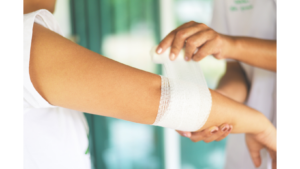Wound healing is a complex and dynamic process where the body repairs the skin and other wound damage. It restores skin integrity after trauma from accidents or surgeries.
This article reviews the treatment and evaluation of wounds and discusses different stages of the wound healing process.
Introduction
The skin is the body’s largest organ, covering its entire external surface. It is composed of three layers: the epidermis (outer layer), dermis (middle layer), and hypodermis (deeper layer). Overall, the skin’s structure is an intricate network protecting the body against the dangers of the outside environment. These include ultraviolet radiation or UV light, pathogens, harmful chemicals, and mechanical injuries.

Wound healing is essential in complex patients and conditions. Poor management of these cuts, scrapes and puncture wounds can lead to chronic injuries.
Approximately 433,000 Australians suffer from chronic wounds at the cost of $2.85 billion annually in the healthcare system. These figures contribute to the social burden as people who suffer from these injuries are prone to work instability, mental health problems, and recurrent infections.
Wound healing stages immediately begin after an injury. Some may take a few weeks, while others might take years if the damage reaches the deepest layer of the skin.
Following an injury, the body will undergo an automatic series of events, also known as a “cascade of healing,” to repair damaged tissues. This process has four overlapping phases: hemostasis, inflammatory, proliferative, and maturation.
Wound Healing Stages
The human body has a complex system to patch up skin injuries. All wound healing stages are essential for proper recovery.
Phase 1: Hemostasis Stage (The Fire Fighters)
It is the first phase of healing and begins at the onset of the injury. At this stage, the blood clotting system is at work to try and stop the bleeding. The platelets in combination with collagen can result in the activation and aggression of blood clots.
Once blood flow has ceased, the damaged tissues will begin their restoration phase. This stage may last up to two days, depending on the severity of the wound.
Phase 2: Defensive or Inflammatory Stage (The Refuse Collectors)
Once phase one is complete, and the wound is no longer bleeding, the body will activate its key defence mechanism.
The second phase, also known as the defensive or inflammatory phase, is about destroying bacteria and removing dirt. This stage is essential to prepare the tissue bed for the growth of new tissues.
The white blood cells (neutrophils) will enter the wound to clear the debris. They can secrete growth factors and proteins, prompting cells within the immune system to begin tissue repair.
The defensive or inflammatory phase can last around four to six days. It is often accompanied by symptoms such as pain at the injury site, edema, erythema (reddening of the skin), and heat. This is because of the blood that rushes to the wound to repair it.
Phase 3: Proliferative Stage (The Builders)
The focus of the proliferative phase is rebuilding new tissues made of collagen and extracellular matrix. It features three distinct stages – filling the wound, contraction, and wound cover (epithelialization).
The first stage is the formation of shiny, deep red tissues, new blood vessels, collagen and other connective tissues that will fill the wound bed. Next is the contraction, where the new tiny capillaries or margins will pull towards the centre. The new cells will arise from the margins to cover the wound with epithelium.
The proliferative stage often lasts from four to twenty-four days.
Phase 4: Maturation Stage (The Decorators)
The final phase is known as the maturation or the remodelling stage.
The new tissue slowly develops its strength and flexibility. Here, the remodelling of the skin happens, and the wound completely closes. The collagen fibres will begin to align, and there will be an overall increase in tensile strength due to cross-linking.
The maturation stage varies from each wound, but it often begins one day following an injury and can last for a year or longer.
Learn The Phases of Wound Healing and Proper Wound Care with First Aid Training
The human body is known for its complex, remarkable, and dynamic wound healing process. It shows how different systems and care products work together to repair and replace damaged tissues.
Note that the healing process is susceptible to interruption due to different factors. These include local risks such as moisture, infection, maceration, and systemic, such as age, nutritional status, and body type.
When proper wound care is applied, the body can work in wondrous ways to heal and revitalize damaged tissues.
It is easy to make mistakes with wound care without first aid training. Consider getting a first aid course to ensure a smooth healing process without interruption. Learn the proper washing techniques, bandage application, and use of medications and ointments.
